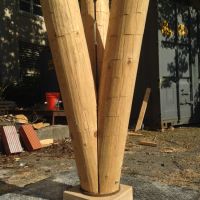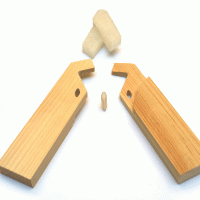Tag: connection-design
-
 Design, mechanics, and optimization of interlocking wood jointsResearch, 2017 - Present
Design, mechanics, and optimization of interlocking wood jointsResearch, 2017 - PresentDespite the longstanding craft of interlocking wood joints in North American and East Asian carpentry, modern timber structures frequently use metal connectors in mid-rise construction. This research explores the structural capabilities of interlocking joints between beams and columns for mid-rise timber frame construction. Research methods include parametric design, structural modelling, digital fabrication, and experimental load testing.
-
 New Structural Systems in Small-Diameter Round TimberAurimas Bukauskas, MIT BSA Thesis, 2015
New Structural Systems in Small-Diameter Round TimberAurimas Bukauskas, MIT BSA Thesis, 2015Trees, when used as structural elements in their natural, round form, are up to five times stronger than the largest piece of dimensioned lumber they could yield. Additionally, these whole-timbers have a lower effective embodied carbon than any other structural material. When combined into efficient structural configurations and joined using specially-engineered connections, whole- timber has the potential to replace entire steel and concrete structural systems in large-scale buildings, bridges, and infrastructure. Whole-timber may be the most appropriate structural solution for a low-carbon and fully renewable future in both developed temperate regions and the developing Global South. To reduce barriers to adoption, including project complexity and cost, a standardized “kit of parts” in whole-timber is proposed. This thesis proposes new designs for the first and most important element of this kit: a structurally independent column in whole-timber. A 20’ compound column in whole-timber is prototyped at full-scale. New, simple calculation methods are developed for estimating the buckling capacity of tapered timbers. Based on conservative assumptions, the embodied carbon of whole-timber column systems is shown to be between 30% and 70% lower than conventional steel systems.
-
 Prototyping 3D-printed structural connectionsResearch, 2015
Prototyping 3D-printed structural connectionsResearch, 2015This research studies the potential of fabricating structural connections additive manufacturing, or 3D printing. Unlike typical bolt-and-plate connections that are mass-produced from sheet material, 3D printed connections can have highly variable geometry due to its digital nature. This technology not only makes connection design and fabrication more accessible and flexible, but also asks us to reconsider the relationship between the connection, the connected parts, and the forces transferred between them. The ability of 3D printers to produce intricate parts with fine details makes it possible to produce connections that can wrap around connected members and transfer forces through surface texture induced friction. It also opens up the possibility of integrating snap-fit behavior into connection design to make assembly faster and easier. The research starts with connection geometry exploration, with a goal to parameterize form and link it to structure behavior. Parallel these efforts is connection prototyping using a range of digital fabrication techniques.


